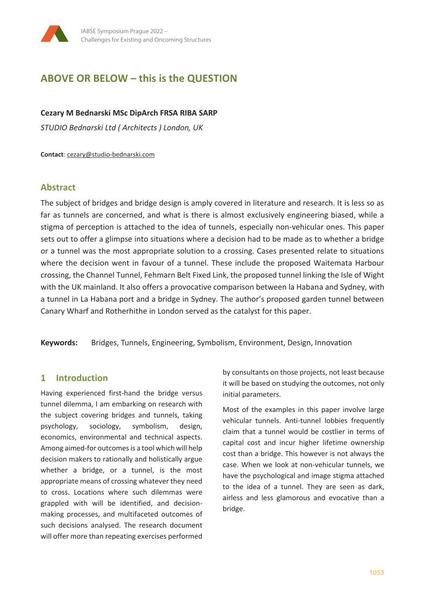ABOVE OR BELOW – this is the QUESTION

|
|
|||||||||||
Détails bibliographiques
| Auteur(s): |
Cezary M. Bednarski
(STUDIO Bednarski Ltd ( Architects ) London, UK)
|
||||
|---|---|---|---|---|---|
| Médium: | papier de conférence | ||||
| Langue(s): | anglais | ||||
| Conférence: | IABSE Symposium: Challenges for Existing and Oncoming Structures, Prague, Czech Republic, 25-27 May 2022 | ||||
| Publié dans: | IABSE Symposium Prague 2022 | ||||
|
|||||
| Page(s): | 1053-1062 | ||||
| Nombre total de pages (du PDF): | 10 | ||||
| DOI: | 10.2749/prague.2022.1053 | ||||
| Abstrait: |
The subject of bridges and bridge design is amply covered in literature and research. It is less so as far as tunnels are concerned, and what is there is almost exclusively engineering biased, while a stigma of perception is attached to the idea of tunnels, especially non-vehicular ones. This paper sets out to offer a glimpse into situations where a decision had to be made as to whether a bridge or a tunnel was the most appropriate solution to a crossing. Cases presented relate to situations where the decision went in favour of a tunnel. These include the proposed Waitemata Harbour crossing, the Channel Tunnel, Fehmarn Belt Fixed Link, the proposed tunnel linking the Isle of Wight with the UK mainland. It also offers a provocative comparison between la Habana and Sydney, with a tunnel in La Habana port and a bridge in Sydney. The author’s proposed garden tunnel between Canary Wharf and Rotherhithe in London served as the catalyst for this paper. |
||||
| Mots-clé: |
design ponts innovation tunnels
|
||||
| Copyright: | © 2022 International Association for Bridge and Structural Engineering (IABSE) | ||||
| License: | Cette oeuvre ne peut être utilisée sans la permission de l'auteur ou détenteur des droits. |
||||
